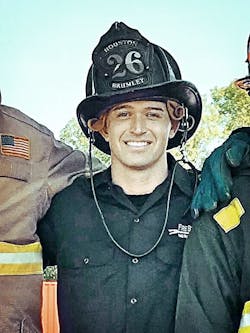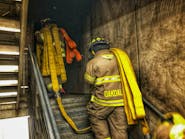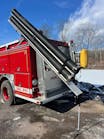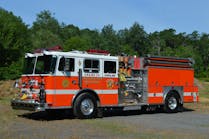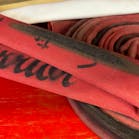Making the Push: The Foundations of a Flowing-While-Advancing Fire Attack - Part 1
For some firefighters, flowing water while advancing a hoseline is neither within their current abilities as a nozzle firefighter nor is it a practiced technique at the department level. By contrast, there are departments whose common practice is flowing water from the time the nozzle is first opened until the fire room is reached.
For centuries, it has been known that a flowing handline provides the surest means of positively impacting the interior fire environment. With the release of the three-part UL study, “The Impact of Fire Attack Utilizing Interior and Exterior Streams on Firefighter Safety and Occupant Survival,”1 we now have quantifiable evidence that supports flowing water long before a line is stretched interior to the seat of the fire. While there continues to be some ambiguity as to what it means to apply “fast water,” the need for lines to stretch interior has not changed.
Several key study findings support a flowing-while-advancing fire attack. Water directed at the ceiling level not only allows for surface cooling, but it also causes a rapid contraction of super-heated gases. This creates additional space in the compartment to pull heated air, smoke and other harmful byproducts away from the floor where both civilians and firefighters alike must survive. In many cases, overall visibility will improve, as well.
These studies showed that a flowing handline can change the course of direction of the fire’s original flow path; especially when a ventilation point is created opposite of the handline, the products of combustion can be moved away from the nozzle, allowing an influx of cleaner air. It should be noted that when moving down a hallway toward a compartment that was heavily involved in fire, similar impacts were made on the fire compartment when companies flowed water while advancing as when they decided to shut down the flow, advance the line, then reestablish water flow. This does not mean that the benefits to a flow-and-move fire attack were not noticeable in the hallway and the rest of the structure located behind the nozzle. Once water flow ceases, interior temperatures will begin to rebound almost immediately; in fact, within 10–15 seconds, temperatures will often return to the same as those found pre-water application. Knowing this should cause us to limit the number of times the nozzle bail is shutdown, if at all, until complete knockdown of the fire has taken place.
If flowing water while advancing provides known benefits, why is it not an industry standard? The answer to that question is because this operation falls within the realm of “easier said than done.” As with any tactic, there are some foundational pieces that need to be intact before a flow-and-move fire attack can be added to an engine company’s arsenal. We will explore some of the basic elements that will aide in its implementation.
Attack package
Departments must provide an attack package that works in favor of the end-users operating the line if they are to ever expect a flow-and-move fire attack to be a viable option. There are several contributing factors to whether the system is favorable, and it must be understood that none of them work independently from the other. Understanding how each piece of a fire attack system is interrelated will create a blueprint for purchasing decisions. Nozzles should be purchased according to target flow, hose should be matched to the selected nozzle in terms of flow and pressure characteristics, and apparatus should be designed, first and foremost, to support an offensive fire attack.
Target flow should be the starting point for any changes in how a department fights fire. Setting realistic gallon-per-minute (gpm) flow rates is not done sitting behind a desk, flipping through sales catalogues. Intentional efforts to place a variety of options in the hands of the men and women who will be tasked with using the equipment are a must. Scenario-based training should be incorporated into this process, as skewed results are a possibility when nozzles and hose are only tested by appearance or in situations that do not replicate fireground tasks.
As Dave Fornell explains in the Fire Stream Management Handbook: "It was one thing to desire 200 gpm from a 1¾-inch line and quite another to handle the actual flow. No amount of pad and pencil calculating can equal an hour of moving the high flow line around inside a training building.”2
NFPA 1710: Standard for the Organization and Deployment of Fire Suppression Operations, Emergency Medical Operations, and Special Operations to the Public by Career Fire Departments states that for a residential fire attack, the first two handlines in service should have a minimum combined flow rate of 300 gpm.3 This has led to an industry standard target flow of at least 150 gpm from a single, small-diameter line. While fire flow formulas may indicate that fire contained to a typical 10 x 10-foot bedroom would require far less gpm flow, meeting this NFPA standard will assist in exceeding the flow demands that are now placed on engine companies due to an increase in heat release rates in the modern fire environment. There is, however, an upper flow limit to what can be expected from an attack package. Hose diameter and construction properties, friction loss, and reaction forces create the usable threshold, and negative consequences result when those limits are exceeded. Further, in flow testing completed by Escambia County, FL, Fire Rescue, it was determined that the total amount of water an engine company engaged in fire attack was able to flow actually decreased as higher target gpm flow rates increased. This was due to firefighter fatigue and the need to stop the flow of water from the handline on a more frequent basis.
A balance must be found between flow rates, stream application abilities and nozzle reaction. Consider also what the normal staffing level is on a single handline. A department that will regularly only have two firefighters on a handline may rightly opt for target flow below that of a department that is capable of staffing three or more. Obviously, as hose diameter increases, the potential to flow a greater volume of water increases as well. Staffing can be a concern in moving medium-diameter hoselines. Additional engine companies should be added early into the incident when large water flow might be required. The fire will determine the proper hoseline size, not department staffing levels. Dry-stretching medium-diameter handlines as close to the immediately dangerous to life and health (IDLH) environment as possible is often advantageous on the under-staffed fireground. Similarly, consider deploying an additional dry line rather than dragging a charged line to a new division. When the need for greater flow arises, departments should not be trying to create a solution within an under-sized hoseline. Once a target flow is established, then the nozzles that meet that target flow can be considered for purchase.
Rules of Thumb for Mobile Handline Flow Rates
- 1¾-inch line: 150 to 200 gpm
- 2-inch line: 200 to 250 gpm
- 2½-inch: 250 to 300 gpm
Not considering water supply, the limiting factor in any firefighter’s ability to flow large volumes of water is how quickly they are fatigued as the result of water moving out of the nozzle, otherwise known as nozzle reaction. Simple physics tells us that the force required to push water through the hose and nozzle system is acting up the nozzle firefighter equally and oppositely of the direction of water flow. Nozzle reaction is measured in pounds of force, and it should be given substantial consideration in the decision-making process.
The acceptable amount of nozzle reaction has been studied at great length by individuals such as Dave Fornell and Andy Fredericks. One of the common conclusions of studies such as these is that pushing the limits of the nozzle reaction comes at a cost; specifically, mobility, stream application and the time allotted until muscles fatigue are all sacrificed. Therefore, Fredericks determined that nozzle reaction should remain as close to 70 lbs. of force as possible when a single firefighter is absorbing the reaction forces.4 Nozzle reaction is directly correlated to the relationship between gpm flow and nozzle tip pressure. Determining the exact amount of nozzle reaction is possible for both combination and smoothbore nozzles by using the following equations:
Combination: Nozzle reaction = 0.0505 x flow rate (gpm) x the square root of the nozzle pressure
Smoothbore: Nozzle reaction = 1.57 x (tip diameter x tip diameter) x nozzle pressure
Understanding that the flow rate and nozzle operating pressure are the two determining factors in nozzle reaction, we can come to a couple of conclusions when selecting a nozzle. To decrease nozzle reaction, there are three options: 1) chose a nozzle with a lower flow rate, 2) choose a nozzle that has a lower operating pressure or 3) choose a nozzle with both a lower flow and tip pressure.
Rather than arguing whether a department should be using a combination nozzle or a smoothbore nozzle, focusing on a shift from high nozzle operating pressure to low nozzle operating pressure will have a far greater impact. Take for example a combination nozzle flowing 175 gpm. If the nozzle operating pressure is 100 psi, the resulting nozzle reaction is 88 lbs. of force. At the exact same flow rate, a combination nozzle with a 50-psi tip operating pressure will only produce 62 lbs. of force. This 26-pound shift will be immediately noticeable by those tasked with flowing that particular handline.
Something must be sacrificed for the nozzle operating pressure to be reduced, correct? The answer is yes; specifically, the velocity of the water traveling through and out of the hoseline is also decreased. For many, the hesitation to use a lower pressure hoseline is the fear that this will immediately cause the hoseline to kink on a more frequent basis. This is where matching a hose to the nozzle becomes important.
In recent years, Capt. (ret.) Dennis LeGear of the Oakland, CA, Fire Department, has brought to light the important role that both hose construction and the internal diameter of fire hose play in the frequency of kinks. When a balanced hose and nozzle package is implemented, kinks will be the result of human-error on a far greater frequency than hose operating pressure. That is an issue that can easily be solved through department training.
Looking ahead
In Part 2, we will discuss proper hose handling, advancing the handline and the importance of the backup firefighter during a flow-and-move attack.
References
1. Zevotek, R., Stakes, K., & Willi, J. Impact of Fire Attack Utilizing Interior and Exterior Streams on Firefighter Safety and Occupant Survival: Full Scale Experiments. UL FSRI. Retrieved from https://ulfirefightersafety.org/docs/DHS2013_Part_III_Full_Scale.pdf.
2. Fornell, D. P. “Fire Stream Management Handbook.” Saddle Brook, NJ: Fire Engineering (1991).
3. National Fire Protection Association. NFPA 1710: Standard for the Organization and Deployment of Fire Suppression Operations, Emergency Medical Operations, and Special Operations to the Public by Career Fire Departments (2016 ed.).
4. Fredericks, A. A. “Little Drops of Water: 50 Years Later, Part 2.” Fire Engineering (March, 2000).
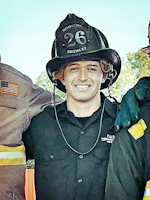
Jonathan Brumley | Firefighter
Jonathan Brumley is a firefighter with the Houston, TX, Fire Department. Beginning in 2009, his experience has spanned three states as both a paid and volunteer firefighter. He holds a bachelor of business administration degree in finance along with various fire service certifications. He recently presented at Firehouse World, authors The Fire Fight blog (the-fire-fight.blogspot.com) and serves as an adjunct fire instructor.
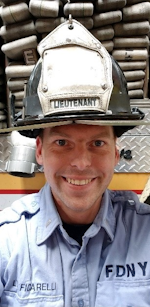
Joe Ficarelli | Lieutenant
Joe Ficarelli is an 11-year veteran of the FDNY. He holds the rank of lieutenant, serving the in borough of Manhattan. Previously, he was a firefighter assigned to L61 and E63 in the Bronx.
